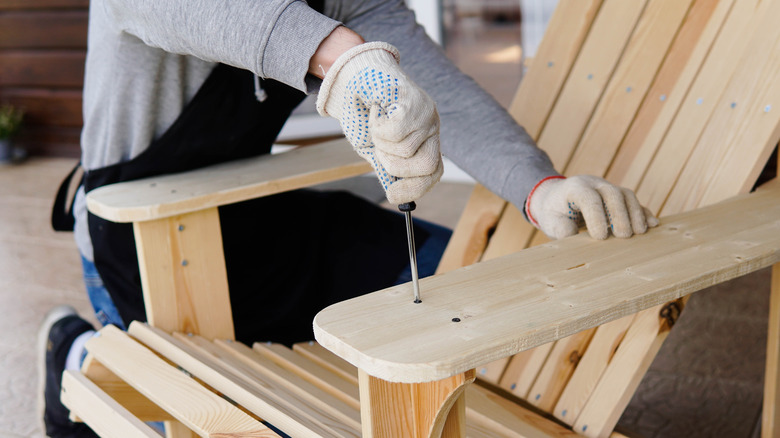The Quick Vinegar Trick To Age The Look Of Your Wood Screws
Achieving the right look can make all the difference when it comes to your DIY projects. What seems like an imperfection can sometimes actually add character to your project. For example, aged and rusted wood screws can help add a vintage look to your furniture, making it seem like your pieces have been around for decades. Imagine transforming a simple wooden shelf into a conversation starter, or a coffee table into an heirloom piece with just aged screws.
Finding naturally aged screws, however, can be a challenge. Even if you raid your shed or garage, you might not have enough. Luckily, there's a simple and quick way to give your wood screws an historical look. All you need is white vinegar, hydrogen peroxide, salt, and a jar. The process also just requires you to soak the screws in a solution before rinsing and drying them.
Vinegar can be a versatile cleaning tool, but its acidity also speeds up the oxidation process, helping you achieve a weathered look in a much shorter period instead of years. Using this household staple results in a perfectly aged screw that blends seamlessly with vintage-style wood finishes or weathered surfaces. So whether you're a DIY enthusiast or a seasoned crafter, mastering this technique is an easy way to transform your new and shiny screws into historical elements in no time. Aged wood screws are among the ways to add charm to your yard and garden with rusted metal. They're perfect for both large and small DIY projects, from coffee tables to jewelry boxes, giving everything a rustic touch.
How to age wood screws using vinegar
You will need white vinegar, hydrogen peroxide, and salt for this project. In doing this, though, it is important to avoid mixing the vinegar and hydrogen peroxide, as this can create toxic peracetic acid, which can cause damage to the eyes and skin. Always use caution when handling these substances. The first step in the process is placing the screws in a container filled with vinegar, adding a bit of salt to the mix, before letting them sit for about four to five hours. Proceed to drain the vinegar, and wipe them carefully before soaking the screws in hydrogen peroxide for around 30 minutes. Once finished, rinse them with water, dry on a paper towel, and apply a lacquer or clear coating to protect them.
The science behind this vinegar trick can be explained through oxidation. This happens when the acetic acid in the vinegar breaks down the screw's surface, allowing the metal to react more easily with oxygen. This then speeds up the natural process that gives the screws the weathered look — like they've been exposed to the elements for years.
But don't dive into this project without being aware of some safety precautions. You'll be working with strong chemicals that can irritate your skin, eyes, and even affect your breathing, so make sure you always wear gloves and work in a well-ventilated area. Also, don't forget to rinse the screws thoroughly once you're done to remove any leftover chemicals. It's also a good idea to test the process on just a few screws first to make sure you get the exact look you're after.
